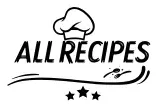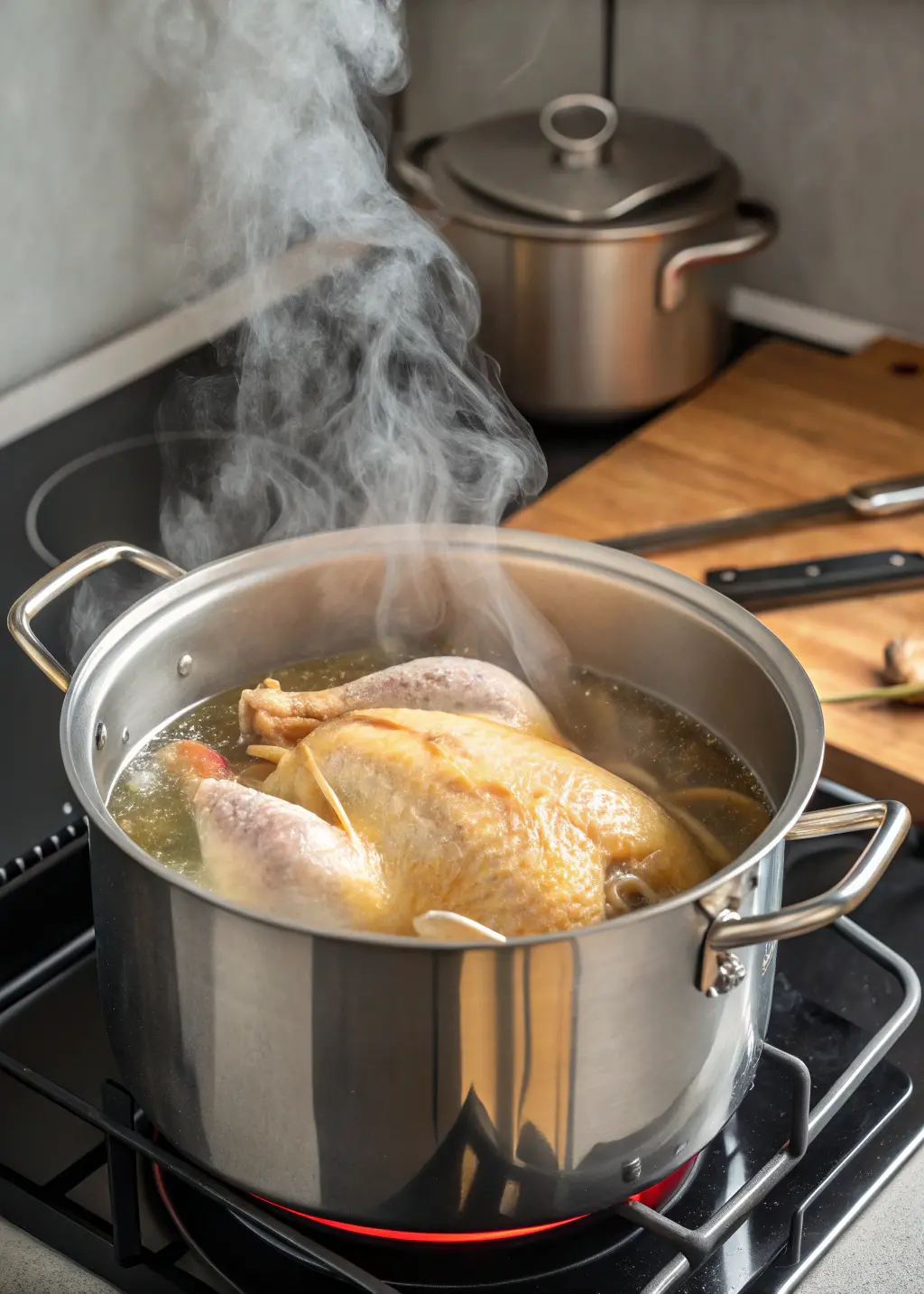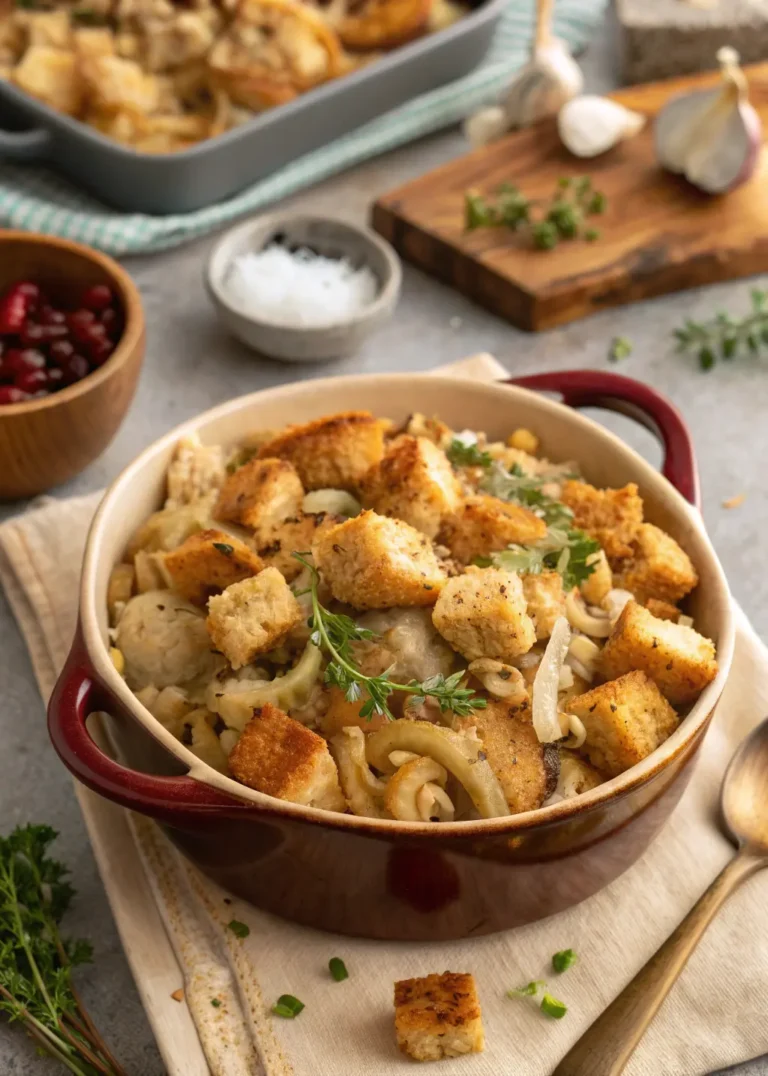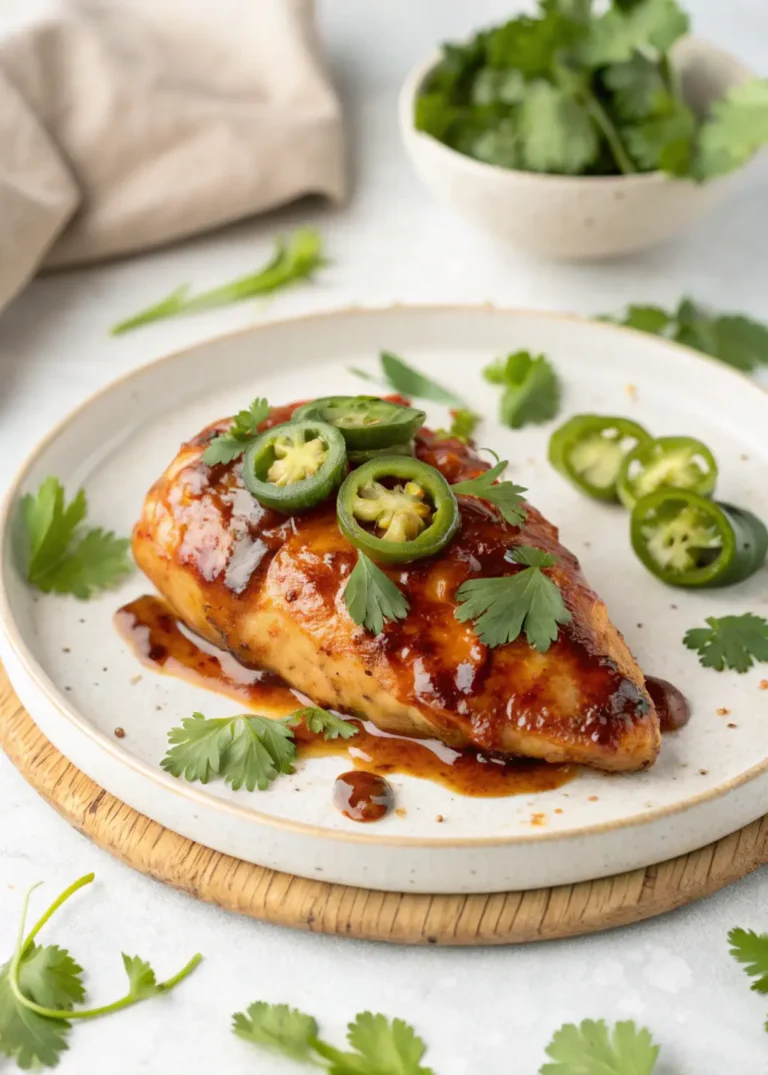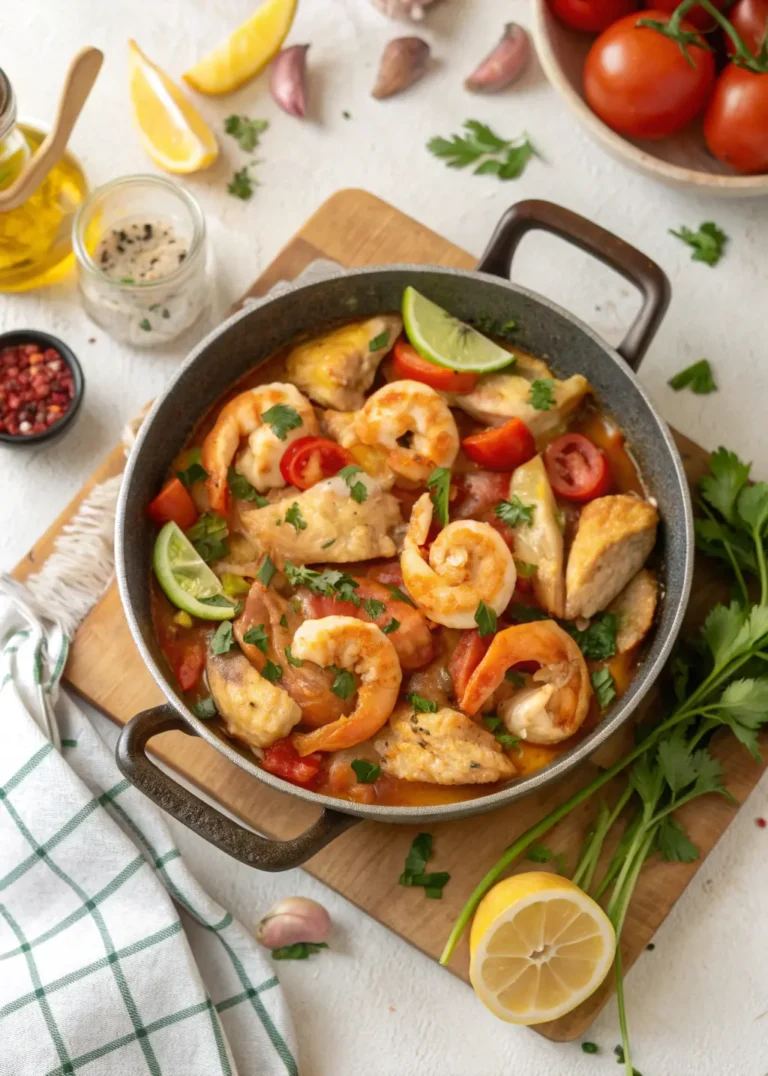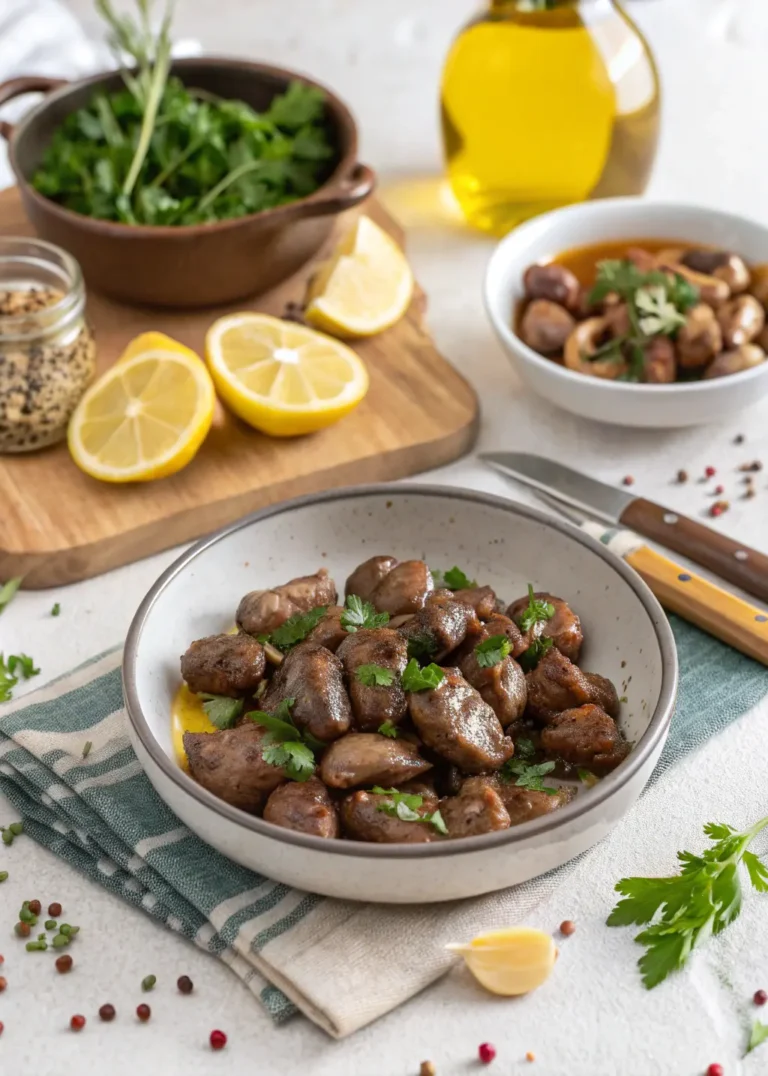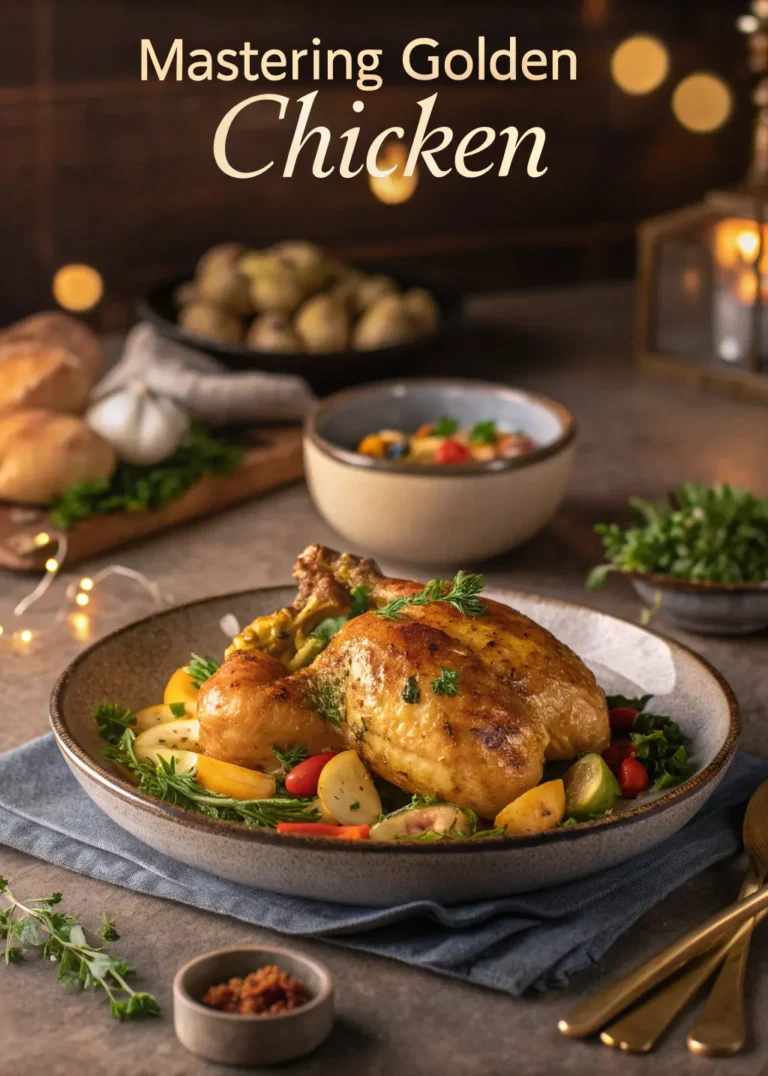How Long to Boil Chicken: A Simple Guide to Get It Just Right
Picture this: You’re standing in your kitchen at 6 PM, staring at raw chicken breasts, with hungry family members asking “When’s dinner?” for the third time. You know boiling chicken is supposed to be straightforward, but that nagging voice in your head whispers, “What if it’s too dry? What if it’s undercooked?”
We’ve all experienced that moment when something as fundamental as boiling chicken feels overwhelming. Whether you’re a busy parent trying to get a healthy meal on the table, a college student learning to cook beyond instant noodles, or someone who simply wants to master this essential cooking skill, you deserve to feel confident in your kitchen. Today, we’re going to eliminate the guesswork and give you the exact timing, techniques, and insider tips that will make perfectly boiled chicken your new superpower.
Table of contents
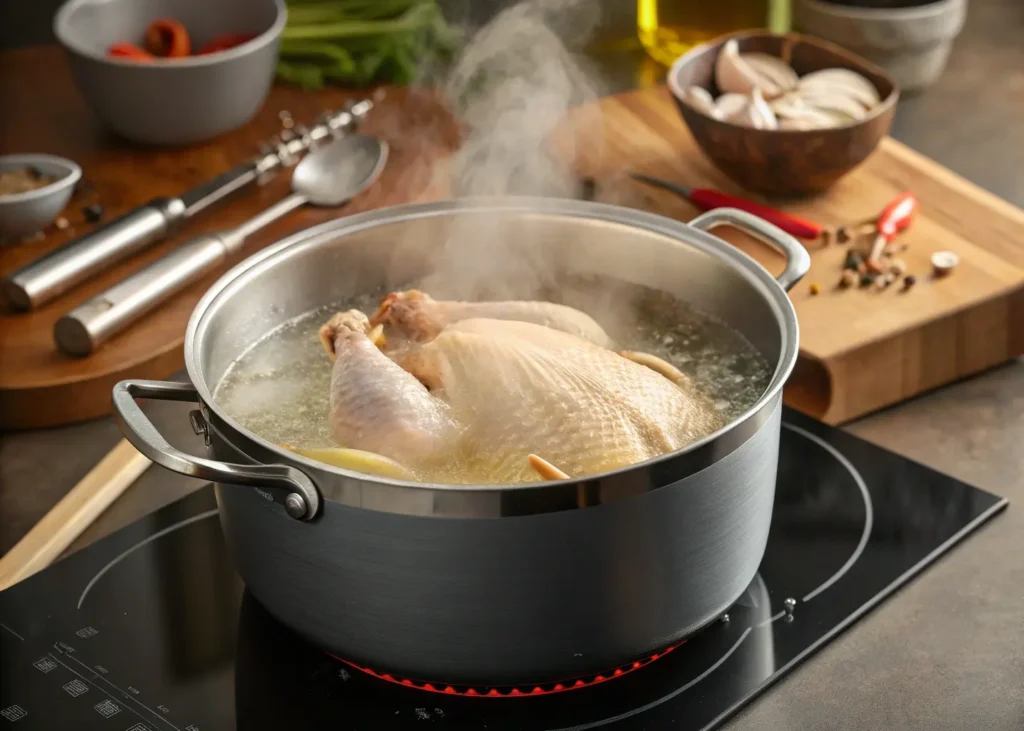
Understanding the Basics of How Long to Boil Chicken
Why Timing Matters When You Boil Chicken
Getting the timing right when you boil chicken isn’t just about taste – it’s about safety, nutrition, and creating a meal your family will actually enjoy. The USDA mandates that all poultry must reach an internal temperature of 165°F to eliminate harmful bacteria like salmonella and campylobacter. But here’s the catch: overcook your chicken by even five minutes, and you’ll end up with stringy, flavorless protein that resembles cardboard more than dinner.
Proper timing also preserves the chicken’s natural moisture content. When you boil chicken correctly, the proteins coagulate gradually, trapping juices inside. Rush the process or extend it too long, and those same proteins will squeeze out every drop of moisture, leaving you with disappointment on a plate.
Factors That Affect Boiling Time
Several variables influence how long to boil chicken, and understanding these will help you adjust your cooking time accordingly:
Size and thickness play the biggest role in determining cooking time. A thick chicken breast will take significantly longer than a thin cutlet to reach that crucial 165°F throughout. Bone-in pieces require additional time because bones conduct heat differently than meat, creating uneven cooking patterns.
Your starting water temperature matters too. While some cooks prefer starting with cold water for more even heating, others swear by adding chicken to already-boiling water for faster results. We’ll explore both methods and help you choose what works best for your schedule.
Altitude affects boiling time in ways many home cooks overlook. At higher elevations, water boils at lower temperatures, which means your chicken will take longer to cook through. If you live above 3,000 feet, plan to add 5-10 minutes to standard cooking times.
Complete Boiling Times for Different Chicken Cuts
How Long to Boil Chicken Breasts
Chicken breasts represent the most popular choice for boiling, thanks to their lean protein content and versatility. However, they’re also the easiest to overcook, making precise timing essential.
| Cut Type | Weight/Size | Boiling Time | Internal Temp |
|---|---|---|---|
| Boneless Breast | 6-8 oz | 15-20 minutes | 165°F |
| Bone-in Breast | 8-12 oz | 25-30 minutes | 165°F |
| Thin-cut Breast | 4-6 oz | 10-15 minutes | 165°F |
For boneless chicken breasts weighing 6-8 ounces, your target time is 15-20 minutes once the water returns to a boil. Thicker breasts may need up to 22 minutes, while thinner pieces could finish in as little as 12 minutes. The key is checking internal temperature rather than relying solely on time.
Bone-in breasts require patience. That bone acts as an insulator, slowing heat penetration to the meat closest to it. Plan for 25-30 minutes, and always check the temperature near the bone where cooking takes longest.
How Long to Boil Chicken Thighs and Drumsticks
Dark meat cuts like thighs and drumsticks offer more forgiveness than breasts due to their higher fat content. This extra fat helps maintain moisture even if you accidentally overcook by a few minutes.
| Cut Type | Average Weight | Boiling Time | Internal Temp |
|---|---|---|---|
| Boneless Thighs | 4-6 oz | 20-25 minutes | 165°F |
| Bone-in Thighs | 5-8 oz | 30-35 minutes | 165°F |
| Drumsticks | 3-5 oz | 25-30 minutes | 165°F |
Boneless thighs typically finish in 20-25 minutes, while their bone-in counterparts need 30-35 minutes. Drumsticks fall somewhere in between at 25-30 minutes, depending on size.
How Long to Boil a Whole Chicken
Boiling a whole chicken requires the longest cooking time but rewards you with the most flavorful results. A 3-4 pound bird needs approximately 60-75 minutes, while larger chickens weighing 4-6 pounds may require up to 90 minutes.
The challenge with whole chickens lies in ensuring even cooking throughout. The breast meat will finish before the thigh meat, so you’ll need to check temperatures in multiple locations before declaring victory.
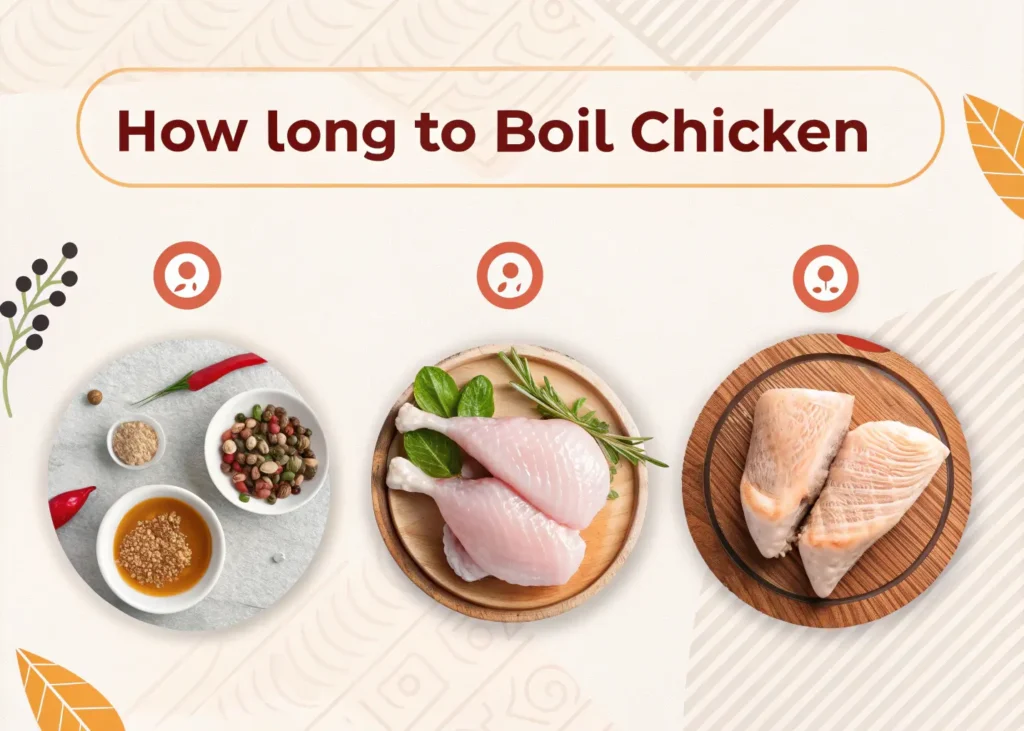
Step-by-Step Method: How to Boil Chicken Perfectly Every Time
Essential Equipment and Ingredients
Success starts with having the right tools and ingredients on hand. You don’t need expensive equipment, but certain items will make your life significantly easier.
| Equipment | Purpose |
|---|---|
| Large pot with lid | Even cooking and heat retention |
| Instant-read thermometer | Accurate temperature checking |
| Tongs | Safe handling of hot chicken |
| Large cutting board | Prep and resting space |
| Fine-mesh strainer | Removing foam and impurities |
Your ingredient list can be as simple or complex as you prefer:
| Ingredient | Amount | Purpose |
|---|---|---|
| Chicken pieces | As needed | Main protein |
| Water | Enough to cover + 2 inches | Cooking medium |
| Salt | 1 tsp per quart of water | Flavor enhancement |
| Bay leaves (optional) | 2-3 leaves | Subtle aroma |
| Black peppercorns (optional) | 6-8 whole | Mild seasoning |
| Onion quarter (optional) | 1 medium | Flavor base |
The Perfect Boiling Technique
Step 1: Preparation Remove your chicken from the refrigerator 20-30 minutes before cooking. This allows the meat to come closer to room temperature, promoting more even cooking. Pat each piece dry with paper towels and season lightly with salt if desired.
Step 2: Setting Up Your Pot Choose a pot large enough that your chicken pieces have room to move freely. Overcrowding leads to uneven cooking and extended cooking times. Fill the pot with enough cold water to cover the chicken by at least two inches.
Step 3: The Cooking Process Place your chicken in the cold water and bring everything to a boil over medium-high heat. This gradual heating method helps prevent the outside from cooking too quickly while the inside remains raw.
Once the water reaches a rolling boil, reduce heat to maintain a gentle simmer. Rapid boiling creates tough, stringy chicken, while gentle simmering produces tender, juicy results. You should see small bubbles breaking the surface consistently, but not violent churning.
Step 4: Timing and Temperature Start your timer based on the guidelines provided earlier, but remember that your thermometer has the final say. Insert the probe into the thickest part of the meat, avoiding bones which can give false readings.
Pro Tips for Moisture Retention
The difference between good boiled chicken and exceptional boiled chicken lies in the details. Here are techniques that professional chefs use to guarantee moist, flavorful results:
Use the ice bath method for chicken destined for cold dishes like chicken salad. Immediately after reaching 165°F, transfer the chicken to a bowl of ice water. This stops the cooking process instantly, preventing overcooking from residual heat.
Let it rest before cutting. Allow boiled chicken to rest for 5-10 minutes before slicing or shredding. This resting period allows juices to redistribute throughout the meat, creating more even moisture distribution.
Save that cooking liquid – it’s basically homemade chicken broth. Strain out any foam or impurities, and you’ll have a flavorful base for soups, rice dishes, or gravies.
Flavor Enhancement: Making Your Boiled Chicken Taste Amazing
Seasoning the Water for Better Taste
Plain water produces plain chicken. Transform your boiling liquid into a flavor powerhouse with these additions:
- Aromatic vegetables: Add quartered onions, celery stalks, and carrot chunks to create a vegetable broth base
- Herb combinations: Try classic combinations like thyme and rosemary, or experiment with oregano and basil
- Citrus elements: Lemon or lime juice brightens the final flavor
- Garlic cloves: Crush 3-4 cloves and add them whole for subtle garlic notes
- Wine substitution: Replace up to half the water with white wine for sophisticated flavor depth
Quick Marinade Options
Even a 30-minute marinade can significantly impact your chicken’s final taste. Try these quick options:
Mediterranean blend: Olive oil, lemon juice, garlic, oregano, and black pepper Asian-inspired: Soy sauce, rice vinegar, ginger, and sesame oil Herb butter: Melted butter mixed with fresh herbs and garlic powder
Common Mistakes When Learning How Long to Boil Chicken
Overcooking Issues
Overcooked chicken exhibits several telltale signs: the meat shreds easily but feels dry, the exterior appears white and chalky, and the texture resembles cotton more than protein. Unfortunately, there’s no way to reverse overcooking, but you can salvage the situation by using the chicken in dishes with plenty of sauce or moisture.
Undercooking Dangers
Undercooked chicken poses serious health risks. Never rely on color alone to determine doneness – some chickens may appear white while still harboring dangerous bacteria. Pink juices, soft texture, and internal temperatures below 165°F all indicate the need for additional cooking time.
If your thermometer reads below 165°F, return the chicken to the pot for additional cooking. Check temperature every 2-3 minutes until you reach the safe zone.

Using Your Perfectly Boiled Chicken
Shredding and Storage Tips
Properly cooked chicken shreds easily with two forks or by hand once cooled. For the finest shreds, work while the chicken is still warm but cool enough to handle safely.
Store shredded chicken in the refrigerator for up to four days or freeze for up to three months. Portion into meal-sized containers for easy weeknight dinners.
Recipe Applications
Your perfectly boiled chicken serves as the foundation for countless meals:
- Chicken salad variations with different mayonnaise-based or vinaigrette dressings
- Soup additions for quick protein boosts in any broth-based soup
- Taco and burrito fillings seasoned with your favorite spice blends
- Pasta dishes combined with vegetables and sauce
- Meal prep bowls paired with grains and roasted vegetables
Nutritional Benefits of Boiled Chicken
Boiling represents one of the healthiest cooking methods for chicken. Without added fats, you’re getting pure protein – approximately 25 grams per 3.5-ounce serving of chicken breast. This cooking method preserves water-soluble vitamins better than high-heat methods like grilling or frying.
The lean protein content supports muscle maintenance and weight management goals, while the low sodium content (when you control the salt addition) makes it suitable for heart-healthy diets.
Frequently Asked Questions About How Long to Boil Chicken
How long to boil chicken breast to ensure it’s fully cooked? Boneless chicken breasts typically need 15-20 minutes of boiling time, while bone-in breasts require 25-30 minutes. Always verify with a meat thermometer that the internal temperature reaches 165°F.
Can you boil chicken from frozen, and how does this affect timing? Yes, you can boil frozen chicken, but add 50% more cooking time to the standard boiling times. For frozen boneless breasts, plan for 22-30 minutes instead of 15-20 minutes.
How long to boil chicken thighs compared to chicken breasts? Chicken thighs take slightly longer due to their higher fat content and denser muscle structure. Boneless thighs need 20-25 minutes, while bone-in thighs require 30-35 minutes.
What’s the best way to tell if boiled chicken is done without a thermometer? While a thermometer provides the most reliable results, you can check if juices run clear when pierced, the meat pulls away from bones easily, and there’s no pink color in the thickest part.
Your Next Steps to Chicken Boiling Mastery
Mastering how long to boil chicken isn’t just about following a timer – it’s about understanding the science behind safe, delicious cooking that brings confidence to your kitchen. Whether you’re boiling chicken breasts for meal prep Sunday or preparing a whole chicken for family dinner, the techniques and timing guidelines we’ve covered will ensure you get perfectly cooked, juicy results every time.
Remember, the magic number is always 165°F internal temperature, but the journey to get there varies based on your chicken cut, size, and cooking method. Start with our timing guidelines, use your thermometer as your best friend, and don’t be afraid to adjust based on your specific situation.
Ready to put these techniques into practice? Start with boneless chicken breasts this week – they’re forgiving and cook quickly. Try the Mediterranean marinade we mentioned, and don’t forget to save that flavorful cooking liquid for tomorrow’s soup base.
The next time someone asks “How long does chicken take to boil?” you’ll not only know the answer – you’ll be able to teach them the why behind the timing. Your family will thank you, your meal prep game will be stronger, and most importantly, you’ll never have to worry about dry, overcooked chicken again.
Have you given our recipe a try?
There are no reviews yet. Be the first one to write one.
